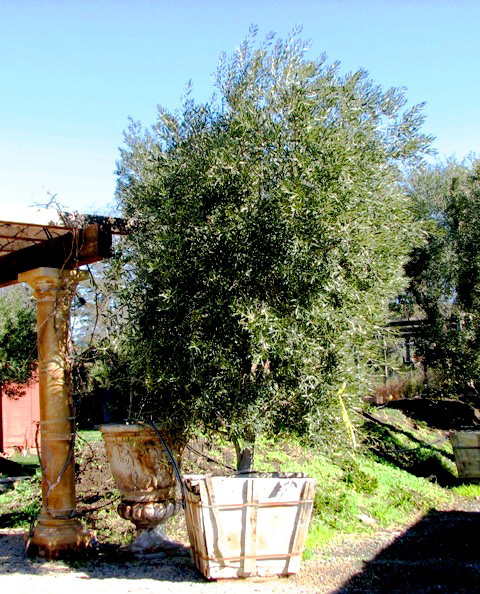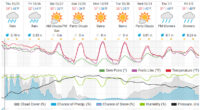
Karen Boness | The Sonoma Garden — Olive trees (Olea europaea) are icons of the water wise garden in Northern California. They are immensely popular in drought tolerant landscape design. What’s not to like about these sun-loving, evergreen gems? They save money on the water bill. They thrive in barren and rocky soil. They are stalwart in the face of searing summer temperatures. Their trunk and branching structure become more beautiful over time — gnarled and ancient looking. Their silvery grey-green leaves shimmer in the rain and sparkle at sunset. They cast a lovely shade space under their canopy. You can up light them for dramatic, nocturnal garden viewing.
Additionally, that lovely fruit that can be cured for eating or transformed into tasty, nutritious olive oil. Ah, here is the potential problem – the fruit. Olive trees are typically copious fruit producers. If you don’t intend to harvest for consumption you will have a big mess that can stain and smear sidewalks and decks. And it is a lot of work to clean it up!
Luckily, the plant growing industry has cultivated fruitless olive trees for landscapers and homeowners alike. What many people don’t know is that we actually have a number of fruitless olive tree options:
1) Larger, single-trunk or multi-trunk fruitless trees with the look and feel of a classic olive tree. Some of these cultivars are well-known such as Swan Hill, Majestic Beauty, and Wilsonii. They have been available in the industry for a long time. A home-owner can expect all of these fruitless trees to reach 25-30’ tall and wide over time. There are other fruitless olive tree cultivars in this size range that many people haven’t heard about. I recently bought some “Arizona Fruitless” trees for a client. They are basically the same thing as “Swan Hill” but developed by a different grower since the “Swan Hill” patent expired. All of these trees are excellent specimens that can be used as focal points, developed into an ornamental front grove, or used to line a driveway.
2) Small tree or large sized shrub fruitless olive. If you have a smaller space such as a patio or tight corner in the garden consider the “Skylark” cultivar. You can plan on this tree growing to about 12’ tall and wide. It is often offered at the nursery as a multi-trunk plant but you can prune away outer branches and train it as a single trunk tree and use it as a focal point. It can also be used as a tall, natural screening hedge.
3) Medium sized fruitless olive shrub. I love the “Little Ollie” fruitless olive cultivar. It grows 4’ to 6’ tall and wide and maintains a relatively neat, roundish form. You can use this shrub for density and structure in any water-wise drought tolerant garden. It is also perfect for formal gardens due to its round form. It can easily be kept at 3’x3’ for smaller spaces.
Note that some fruitless olive trees do bear a little bit of fruit sometimes. Some nurseries now certify their trees as fruitless. Others tell you that the tree will bear some fruit only if there is a pollinator nearby. The term “low fruiting” is being used more often to cover the occasional situation season when fruit-bearing occurs. So check with your nursery before you buy. And have fun with your fruitless olive trees!






I’d like to get 2 fruitless olive trees for a residence. I’m looking for multi trunk size somewhere in the neighborhood of 60 inch to 120 inch box.
Please let me know the cost of the trees, transportation to the LA area, and installation/planting (if you do that).
Thanks!
Looking for two Skylark multi trunk trees for our new garden design…larger is more desireable.